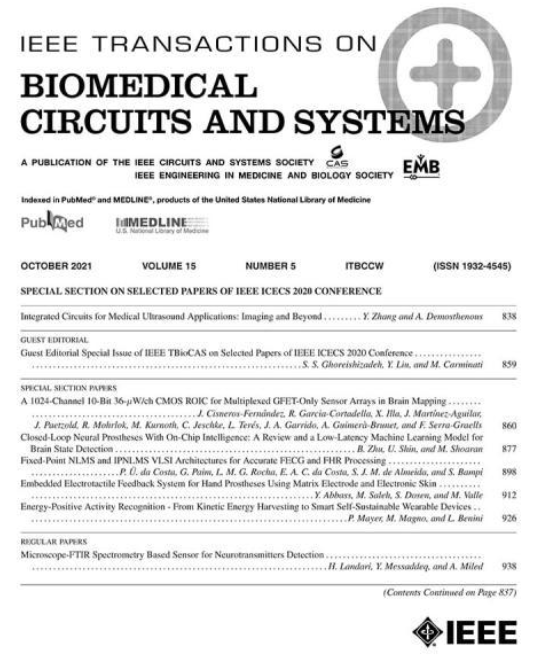无源谐振电路在支架内局部脉冲波速度测量中的设计
IF 4.9
2区 医学
Q2 ENGINEERING, BIOMEDICAL
IEEE Transactions on Biomedical Circuits and Systems
Pub Date : 2016-01-20
DOI:10.1109/TBCAS.2015.2496420
引用次数: 6
摘要
支架内再狭窄是支架植入术后常见的并发症。本文研究了一种被动式传感器系统的设计,该系统将集成到支架中,通过测量局部脉冲波速度(PWV)来检测支架内再狭窄。该系统采用由电容式压力传感器和线圈组成的两个谐振电路作为应答器。压力传感器位于支架的近端和远端。施加频率恒定的交变外部磁场,使得当脉冲波通过时,应答器的共振频率跨越激励频率。可以捕获应答器共振之间的时间延迟以获得PWV。推导了测量系统的模型和应答器设计参数与最小可分辨时延之间的关系。这种相关性是基于应答器共振的3db带宽在测量时间间隔内可能不重叠的标准。这种相关性可用于设计和分析所提出的测量系统的应答器系统。用变容二极管对压力传感器进行了仿真实验,结果表明该模型是有效的,判据是合适的。最后,确定了应答器的相关设计参数,并对其局限性进行了研究。本文章由计算机程序翻译,如有差异,请以英文原文为准。
On the Design of Passive Resonant Circuits to Measure Local Pulse Wave Velocity in a Stent
In-stent restenosis is a frequent complication after stent implantation. This article investigates the design of a passive sensor system to be integrated into a stent for the detection of an in-stent restenosis by measuring the local pulse wave velocity (PWV). The proposed system uses two resonant circuits consisting of a capacitive pressure sensor and a coil as transponders. The pressure sensors are located at the proximal and distal end of the stent. An alternating external magnetic field with a constant frequency is applied such that the resonance frequencies of the transponders cross the excitation frequency when the pulse wave passes. The time delay between the resonances at the transponders can be captured to obtain the PWV. A model for the measurement system and a correlation between transponder design parameters and minimal resolvable time delay are derived. This correlation is based on the criterion that the 3 dB bandwidth of the transponder resonances may not overlap in the measurement time interval. This correlation can be used to design and analyze a transponder system for the proposed measurement system. In an experiment, in which the pressure sensors have been emulated by varactor diodes, it could be shown that the model is valid and that the criterion is suitable. Finally, the relevant design parameters of the transponders have been identified and their limitations investigated.
求助全文
通过发布文献求助,成功后即可免费获取论文全文。
去求助
来源期刊

IEEE Transactions on Biomedical Circuits and Systems
工程技术-工程:电子与电气
CiteScore
10.00
自引率
13.70%
发文量
174
审稿时长
3 months
期刊介绍:
The IEEE Transactions on Biomedical Circuits and Systems addresses areas at the crossroads of Circuits and Systems and Life Sciences. The main emphasis is on microelectronic issues in a wide range of applications found in life sciences, physical sciences and engineering. The primary goal of the journal is to bridge the unique scientific and technical activities of the Circuits and Systems Society to a wide variety of related areas such as: • Bioelectronics • Implantable and wearable electronics like cochlear and retinal prosthesis, motor control, etc. • Biotechnology sensor circuits, integrated systems, and networks • Micropower imaging technology • BioMEMS • Lab-on-chip Bio-nanotechnology • Organic Semiconductors • Biomedical Engineering • Genomics and Proteomics • Neuromorphic Engineering • Smart sensors • Low power micro- and nanoelectronics • Mixed-mode system-on-chip • Wireless technology • Gene circuits and molecular circuits • System biology • Brain science and engineering: such as neuro-informatics, neural prosthesis, cognitive engineering, brain computer interface • Healthcare: information technology for biomedical, epidemiology, and other related life science applications. General, theoretical, and application-oriented papers in the abovementioned technical areas with a Circuits and Systems perspective are encouraged to publish in TBioCAS. Of special interest are biomedical-oriented papers with a Circuits and Systems angle.
 求助内容:
求助内容: 应助结果提醒方式:
应助结果提醒方式:


